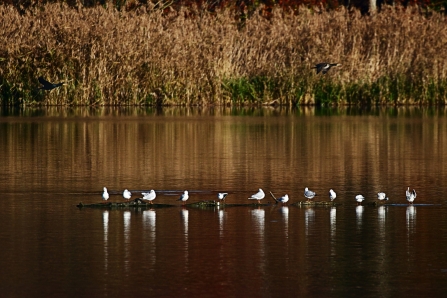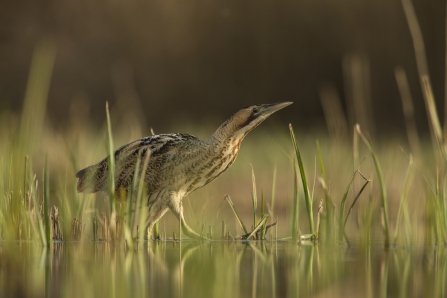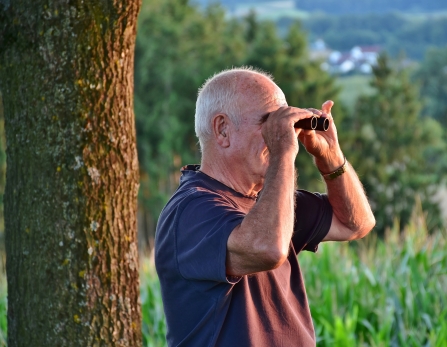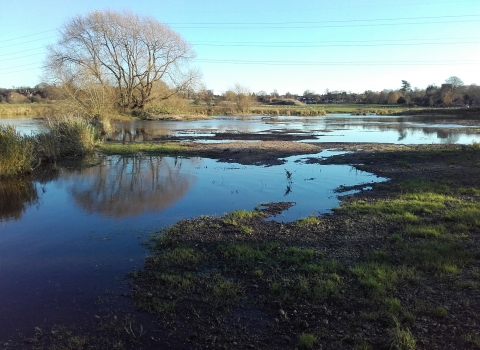Introducing the Trust's Nature Reserve in the Making
After months of negotiation and fundraising, in 2018 quarrying operations ended at Tucklesholme and the transformation from quarry to nature reserve began. Tucklesholme is located on the banks of the River Trent near Barton-under- Needwood. The site has been restored to a wetland habitat providing a home for a number of key breeding species that specialise in this open wetland environment such as oystercatcher, skylark, shelduck and common sandpiper.
Find out how we're turning a working gravel quarry into one of the county's finest nature reserves.

Why Tucklesholme? And why now?
The former gravel quarry had the potential to be restored to a wetland habitat that a whole host of wildlife could use to thrive.
The hard work has only just begun
At over 130 acres, we intend to create a large expanse of reedbed that a whole host a wildlife needs to thrive. So big in fact, that this reedbed will become the largest in Staffordshire's Trent valley.
The Trust is also creating diverse bankside meadows for insects and butterflies. Pathways for walking, picnicing, and informal recreation were installed in the late winter after the quarrying work stopped in 2018.

Credit: Jamie Hall
What wildlife might be there?
The vast reedbeds will be the perfect habitat for bitterns, a secretive member of the heron family that haven't bred in Staffordshire in over 100 years. The bittern is best known for the characteristic "boom", which can be heard from late January as the male establishes his territory. Historically, bitterns were once relatively common in Staffordshire, but numbers plummeted during the 1800s as the reedbeds where these birds live were drained. We hope Tucklesholme will one day be the breeding home of these stunning birds.
The exposed sandy shingles on the southern lake provide valuable nesting habitat to rare birds such as little ringed plover and oystercatcher, while the wet grassland areas offer the perfect spot for lapwing to raise their young."
How did we turn the plan into reality?
Proposals to buy the site started in December 2012. By Spring 2013 a target of £337,000 and a deadline of December was set, and fundraising began. The Trust were delighted when the National Forest approved a grant request of £65,000. This was followed by £20,000 from East Staffordshire Borough Council.
November saw a public appeal launched, with 4,000 letters distributed to Trust members, pushed through letterboxes, and emailed to supporters. The response was overwhelming with over £25,000 raised, from over 400 donations made via post, online, text, and phone. Thank you to everybody who donated to the appeal. We were also grateful to a number of our local groups who came forward to donate proceeds of their various fundraising activities.
A substantial proportion of the target was then raised by a national grant. Staffordshire Wildlife Trust was one of only 17 organisations from across the UK to receive a grant from the Social Investment Business Group, receiving £177,000 towards the purchase of Tucklesholme Quarry.
The Trust also received a £1,000 donation from Cllr Tim Corbett for Needwood Forest, as part of the Staffordshire Communities Fund.
The final piece of the funding jigsaw came through a legacy which had been left to the Trust.
And after a few last-minute legal glitches, the Trust completed the purchase of Tucklesholme Quarry on Christmas Eve 2013.
The reserve was open to the public on 17th May 2019.

Visiting the reserve
After lots of hard work the reserve is now open to the public. Head here for info on how to visit the site.
Map of the reserve
Map of Tucklesholme

European Regional Development Fund
Works are part-funded by the European Regional Development Fund

